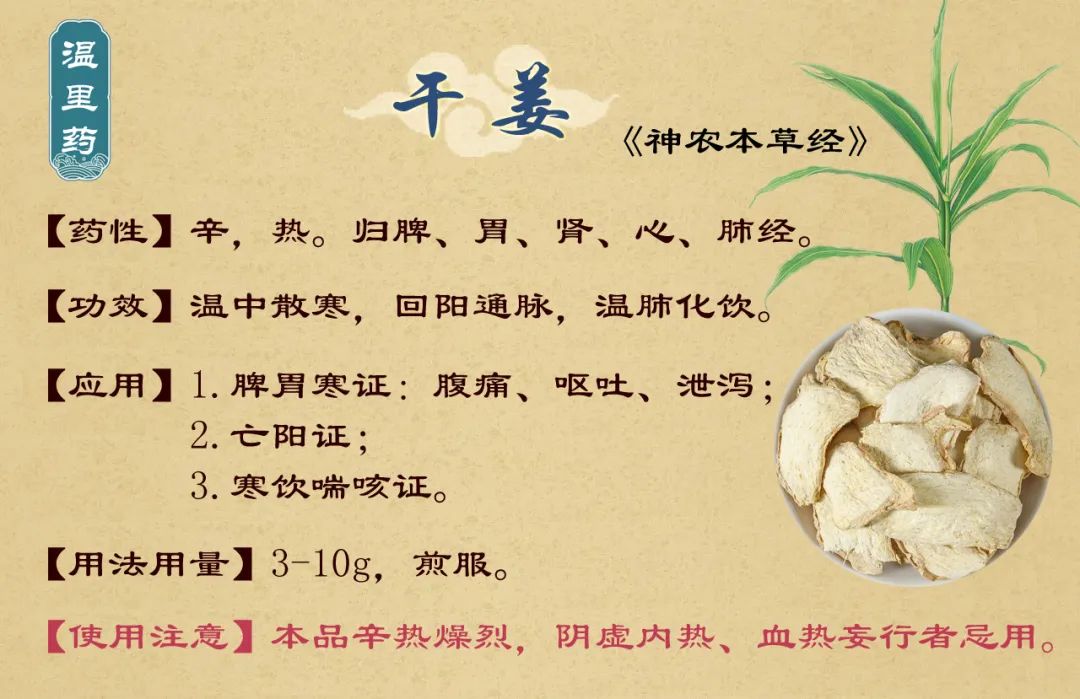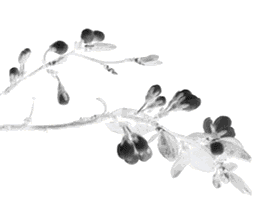
Click above to follow “Learn TCM“!


Source

Gan Jiang (干姜) is derived from mature ginger, and it shares the same plant and medicinal part as Sheng Jiang (生姜), which is its rhizome. This product has a fragrant aroma and a spicy taste. The best quality is characterized by large size, white color, firm texture, and strong fragrance. The variety produced in Sichuan is known for its spiciness and powdery texture, with the best being from Qianwei, Sichuan, referred to as “Qian Gan Jiang”. However, it is important to note that Sheng Jiang does not simply become Gan Jiang through drying. Since the time of Tao Hongjing, it has been recognized that dried Sheng Jiang is not Gan Jiang; he stated: “There are good gingers in Shu, and those from Jingzhou are also good, but neither can be made into Gan Jiang”. Li Shizhen also classified Gan Jiang, Sheng Jiang, and Gan Sheng Jiang as three different medicines in the “Compendium of Materia Medica”. In fact, Gan Jiang and Sheng Jiang are different cultivation varieties of the same plant, with significant differences in field management. Sheng Jiang requires frequent hilling during cultivation to cover the rhizome, as the medicinal part is the rhizome, which is a stem that exhibits phototropism. It seeks sunlight; in forests, trees that do not receive much light grow thin and tall due to this phototropism. Sheng Jiang, being a stem, also seeks sunlight, and frequent hilling encourages its growth. Thus, in late summer and autumn, we see many places where so-called “Zi Jiang” (子姜) is very tender, with long rhizomes, used as a vegetable, having little fiber, and being very tender and crisp, thus used as Sheng Jiang. Gan Jiang, on the other hand, is cultivated without hilling, exposing the rhizome to the soil surface, allowing it to see light, which prevents it from growing excessively and instead allows its internal components to accumulate. The so-called Sheng Jiang grows quickly, and its internal components do not accumulate sufficiently, resulting in a very light product that shrinks on the surface when dried, making it unsuitable for use as Gan Jiang. Gan Jiang, due to its rich internal components, does not shrink much when dried, maintaining its weight and density. The primary difference between the two lies in their cultivation and management methods. Modern research has found that the chemical components of Sheng Jiang and Gan Jiang are not entirely the same, especially in the ratios of some common components, but the correlation with efficacy has not yet been fully explained. However, it at least indicates that in TCM, Sheng Jiang and Gan Jiang are used as two different medicines, not merely differentiated by moisture content, as their chemical compositions and effects are significantly different, which has a relevant material basis.
History

Gan Jiang is recorded in the “Shennong Bencao Jing” as its proper name. The “Compendium of Materia Medica” lists its alternative names as Bai Jiang (白姜), Jun Jiang (均姜), and Gan Sheng Jiang (干生姜), but these alternative names are rarely used in medical texts. The “Shennong Bencao Jing” classifies this herb as a medium-grade medicine, stating that it “treats chest fullness, cough, counterflow qi, warms the middle, stops bleeding, induces sweating, expels wind-damp bi, and alleviates intestinal obstruction and diarrhea”. The “Nai Yi Bie Lu” summarizes the medicinal experiences from the Han to Wei and Jin dynasties, adding that it “treats cold abdominal pain, food poisoning, cholera, distension, wind evil toxins, and skin-related qi stagnation, and stops blood-tinged saliva”. The “Yao Xing Lun” further develops its indications, stating it “treats cold pain in the waist and kidneys, cold qi”, “frequent urination at night”, and expands on the “Shennong Bencao Jing”‘s “expelling wind-damp bi” to include “expelling wind, unblocking the joints of the four limbs, opening the five zang and six fu organs, and expelling wind, toxins, and cold bi”, and adds “breaking blood” to treat “blood stasis”. The “Rihua Zi Bencao” states it can “resolve phlegm, descend qi, treat cramps, vomiting and diarrhea, cold in the abdominal organs, reverse stomach and dry heaving, blood stasis, and stop nasal bleeding, resolve cold and heat toxins, open the appetite, and eliminate food stagnation”. This indicates that by the Tang and Song dynasties, the understanding of Gan Jiang’s functions was quite comprehensive. The “Yixue Qiyuan” summarizes its main functions as “unblocking heart qi, assisting yang, expelling cold from the viscera, and dispelling cold qi from the channels, treating cold abdominal pain”. Wang Haogu added that it “treats cold obstruction in the heart and prolonged redness of the eyes”. Modern summaries based on the records of materia medica and clinical experience indicate that its functions mainly involve warming the middle, warming the lungs, and reviving yang.
Effects and Applications

Gan Jiang, as a warming interior medicine, has its first effect as warming the middle and dispelling cold. In simple terms, it is called warming the middle, without emphasizing pain relief, unlike Fu Zi (附子), which dispels cold and relieves pain. Compared to many warming interior medicines, Gan Jiang’s pain-relieving effect is not very prominent. Its main action is in the middle jiao; any cold in the spleen and stomach, whether it is a cold excess or cold deficiency pattern, can be treated with it, regardless of whether it manifests as pain, distension, reduced appetite, indigestion, diarrhea, nausea, or vomiting. However, it should be used in combination with appropriate herbs; for example, if nausea and vomiting are prominent, it should be combined with herbs that stop vomiting, and if pain is prominent, it should be combined with strong pain-relieving herbs. The second effect is reviving yang, or reviving yang and unblocking the vessels. Fu Zi is used to revive yang and rescue from counterflow. These two herbs are used for yang deficiency patterns, but their effects are expressed differently for profound reasons. Yang deficiency has two main symptoms, one of which is cold extremities, caused by kidney yang decline. Gan Jiang does not act on the kidney channel, so it does not enhance the yang qi in the kidneys, meaning it does not specifically address cold extremities. Gan Jiang primarily enters the heart channel, invigorating the heart’s yang qi, and mainly improves symptoms of fine and weak pulse, hence it is called reviving yang and unblocking the vessels, which is subtly related to its primary entry into the heart channel. Therefore, in yang deficiency patterns, Gan Jiang is only used as an auxiliary herb in Si Ni Tang (四逆汤) alongside Fu Zi. The third effect is warming the lungs and transforming phlegm, used for cough and wheezing caused by lung cold, similar to Sheng Jiang, but with a stronger warming property. It is commonly used in formulas such as Ling Gan Wu Wei Jiang Xin Tang (苓甘五味姜辛汤) for treating cold phlegm cough and wheezing.


Comparison of Gan Jiang and Sheng Jiang

Gan Jiang and Sheng Jiang share the ability to warm the middle, but Gan Jiang’s warming effect is stronger than that of Sheng Jiang. However, Sheng Jiang excels in stopping vomiting, while Gan Jiang is not as strong in this regard. There are differences in the degree of warming and stopping vomiting; Gan Jiang is not completely ineffective in stopping vomiting, but it is not prominent, hence it is used less frequently. Secondly, both can warm the lungs and transform phlegm, with Gan Jiang being stronger than Sheng Jiang in this aspect. The differences are that Sheng Jiang can disperse wind-cold and is often used for wind-cold exterior patterns, while Gan Jiang can revive yang and unblock the vessels, often used as an auxiliary herb for yang deficiency patterns.

In the next issue, we will introduce “Rou Gui” (肉桂). If you have any questions, feel free to leave a message for discussion!
Source: 1. “Lectures by Famous TCM Experts – Zhang Tingmo’s Clinical Chinese Medicine Lecture Notes”, edited by Zhang Tingmo, published by People’s Medical Publishing House; 2. “Chinese Clinical Chinese Medicine”, edited by Zhang Tingmo and Peng Cheng, published by People’s Medical Publishing House; copyright belongs to the original author!



Long press the QR code to recognize and follow us
Learn TCM
We will work hard together!

